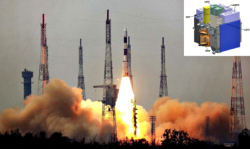Find out the latest thinking about our universe.
-
bystander
- Apathetic Retiree
- Posts: 21577
- Joined: Mon Aug 28, 2006 2:06 pm
- Location: Oklahoma
Post
by bystander » Mon Oct 05, 2015 3:13 pm
 HEAPOW: The Launch of ASTROSAT (2015 Oct 05)
HEAPOW: The Launch of ASTROSAT (2015 Oct 05)
The
Indian Space Research Organization launched Indian's first space observatory,
ASTROSAT, on September 28, 2015 at 10 am (IST). ASTROSAT was launched on an Indian
Polar Satellite Launch Vehicle (PSLV) from the
Satish Dhawan Space Centre,
Sriharikota. ASTROSAT is a multi-wavelength space observatory which carries 5 astronomical instruments: the
UVIT, a pair of ultraviolet telescopes covering the far UV to optical range; the
LAXPC, the Large Area Xenon Proportional Counter, a trio of detctors covering the medium to hard X-ray energy band; the Soft X-ray Telescope (
SXT), an imaging telescope covering the soft to medium X-ray energy band; the
CZTI, a cadmium-zinc-telluride imaging detector covering the hard X-ray band; and the
SSM, an all-sky monitor designed to scan the entire sky every 6 hours to detect transient X-ray sources. The image above shows the launch of the PSLV carrying ASTROSAT, while the inset is a drawing of the observatory with the instruments labelled. ASTROSAT is currently in its post-launch instrument check-out phase, in which each instrument is carefully turned on and evaluated. ASTROSAT will provide a unique platform for the study of neutron stars, black holes, normal stars, galaxies, and the structure and evolution of the Universe. Observing time on ASTROSAT will be competitively awarded starting approximately one year after launch.
IUCAA: ASTROSAT
ISRO: ASTROSAT
Know the quiet place within your heart and touch the rainbow of possibility; be
alive to the gentle breeze of communication, and please stop being such a jerk. — Garrison Keillor
-
bystander
- Apathetic Retiree
- Posts: 21577
- Joined: Mon Aug 28, 2006 2:06 pm
- Location: Oklahoma
Post
by bystander » Tue Oct 13, 2015 3:30 pm
Astrosat First Light: CZT Imager Looks at Crab Nebula
India Space Research Organisation | 2015 Oct 13
[img3="Image of Crab Nebula in hard X-rays above 25 keV. The bright spot near the centre indicates Crab. The effective imaging resolution here is about 10 arcmin. The faint patches outside are `side-lobes’ of the imaging process and they will be suppressed significantly when data from all quadrants are analysed simultaneously, which will also improve the image resolution to better than 8 arcmin."]http://www.isro.gov.in/sites/default/fi ... hyfgje.png[/img3][hr][/hr] Astrosat, India's first Multi-wavelength Space Observatory was successfully launched by ISRO's workhorse launch vehicle PSLV into a 650km orbit on September 28, 2015. Then began the process of putting each of the payloads into operation.The Charged Particle Monitor (CPM) was the first payload to go operational followed by the Cadmium Zinc Telluride Imager (CZTI), the hard X-ray detector on board Astrosat. CZTI was made fully operational on October 5, 2015. Then,on October 6, Astrosat was oriented towards Crab Nebula, remnant of the Supernova detected by Chinese astronomers in the year 1054. The Crab Nebula, which also includes the Crab Pulsar, is the brightest hard X-ray source in the sky, and is very often used to calibrate hard X-ray detectors. ...
The ground support software had been reviewed at multiple levels and was ready to tackle the data immediately after the first orbit of the satellite during the Crab observations. Unfortunately, these software were tested using the benign ground data, and were ill equipped to handle the voluminous on board data. Hence, the first attempt was to just look at the Crab data in the first orbit without going into finer nuances like satellite location etc.
A quick look at the first orbit image showed that Crab Nebula was not detected. ...
Crab Nebula was detected on Oct 9, 2015, observed parallely by both Mission Operation Centreat Peenya, Bengaluru and Payload Operation Centre, IUCAA, Pune. During the first orbit, there was a difficulty in detecting this Crab Nebula as the satellite happened to pass through the South Atlantic Anomaly (SAA) region when Crab was in the field of view. SAA avoidance zone was deliberately kept wide to protect the instruments, and detectors were switched OFF in this interval during the initial days of Astrosat operation. When all the data were systematically analysed and data were selected based on the availability of Crab in the detector field of view, one could see the Crab emerging from Earth's shadow. ...
This is only the beginning, with many more events to unfold…
Know the quiet place within your heart and touch the rainbow of possibility; be
alive to the gentle breeze of communication, and please stop being such a jerk. — Garrison Keillor
-
neufer
- Vacationer at Tralfamadore
- Posts: 18805
- Joined: Mon Jan 21, 2008 1:57 pm
- Location: Alexandria, Virginia
Post
by neufer » Tue Oct 13, 2015 4:07 pm
Chandra X-ray Observatory: images over
the [
Soft] X-ray range of
0.1–10 keV.
https://en.wikipedia.org/wiki/Astrosat wrote:
<<Astrosat's
LAXPC Instrument covers [
Hard] X-ray timing & low-resolution spectral studies over a broad energy band (
3–80 keV), Astrosat will use a cluster of 3 co-aligned identical
Large
Area
X-ray
Proportional
Counters, each with a multi-wire-multi-layer configuration & a Field of View of 1° × 1°.>>
The Compton Gamma Ray Observatory : images over the range of
20 keV to 30,000 MeV.
Art Neuendorffer
 HEAPOW: The Launch of ASTROSAT (2015 Oct 05)
HEAPOW: The Launch of ASTROSAT (2015 Oct 05)
